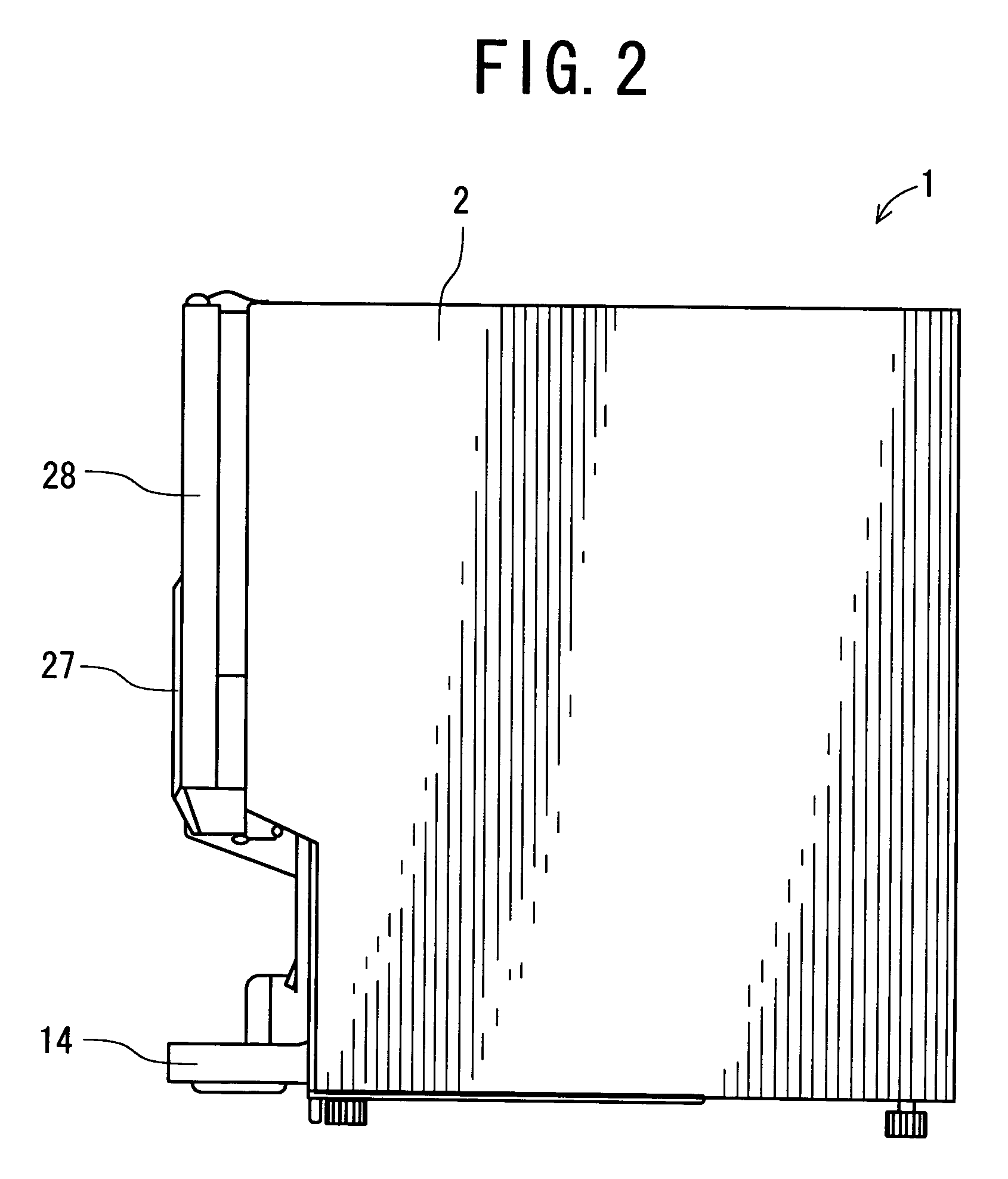Beverage supply device
a technology of a supply device and a supply device, which is applied in the direction of liquid transfer devices, lighting and heating devices, domestic cooling devices, etc., to achieve the effect of effective inhibition of overload operation of compressors, rotational frequency, and promotion of air-cooling of radiators
- Summary
- Abstract
- Description
- Claims
- Application Information
AI Technical Summary
Benefits of technology
Problems solved by technology
Method used
Image
Examples
embodiment 1
[0030] In a first embodiment, a beverage dispenser 1 is a beverage dispenser for use in a restaurant, a coffee shop or the like, and is a device provided with: a BIB unit (not shown) which supplies neutral beverages such as oolong tea and orange juice; and a tank unit 4 which similarly supplies strongly and lightly carbonated and uncarbonated target beverages. Such beverage dispenser 1 has a structure in which the BIB unit is disposed in a main body 2, and the tank unit 4 is externally connected to the main body. Moreover, the BIB unit is shielded behind an openably closed door 28 positioned in a front face of the main body. It is to be noted that the tank unit 4 will be described later in detail.
[0031] The front face of the opening / closing door 28 is provided with an operation section 27 which supplies the beverage from the tank unit 4 and the BIB unit. The section is provided with operation buttons such as buttons S, M, L, and C / P which select a beverage supply amount or a bevera...
embodiment 2
[0068] There will be described hereinafter use of an outside air temperature sensor in load detecting means in a second embodiment. It is to be noted that a control unit 11 is connected to an outside air temperature sensor 70 as the load detecting means disposed in a main body 2 in order to detect an outside air temperature at which a beverage dispenser 1 is disposed as shown in FIG. 5.
[0069] When the temperature detected by the outside air temperature sensor 70 is higher than, for example, +10°C. and lower than +30° C. in such embodiment, the control unit 11 sets a rotational frequency of a compressor 51 to 50 Hz as described above, and sets the rotational frequency of a blower 53 of a radiator 52 to a usual rotational frequency to operate the blower. Moreover, when the temperature detected by the outside air temperature sensor 70 rises at, for example, +30° C. or more, the control unit 11 lowers the rotational frequency of the compressor 51 at 40 Hz, and operates the blower 53 at...
embodiment 3
[0073] There will be described hereinafter use of a cooling water temperature sensor in load detecting means in a third embodiment. In this case, a cooling water temperature sensor 69 is disposed in a water tank 29 in order to detect a temperature of pooled cooling water. It is assumed that the cooling water temperature sensor 69 is connected to a control unit 11.
[0074] When the temperature detected by the cooling water temperature sensor 69 is higher than, for example, +1° C. and lower than +5° C. in such embodiment, the control unit 11 sets a rotational frequency of a compressor 51 to 50 Hz as described above, and sets the rotational frequency of a blower 53 of a radiator 52 to a usual rotational frequency to operate the blower. Moreover, when the temperature detected by the cooling water temperature sensor 69 rises at, for example, +5° C. or more, the control unit 11 lowers the rotational frequency of the compressor 51 at 40 Hz, and operates the blower 53 at a predetermined high...
PUM
 Login to View More
Login to View More Abstract
Description
Claims
Application Information
 Login to View More
Login to View More - R&D
- Intellectual Property
- Life Sciences
- Materials
- Tech Scout
- Unparalleled Data Quality
- Higher Quality Content
- 60% Fewer Hallucinations
Browse by: Latest US Patents, China's latest patents, Technical Efficacy Thesaurus, Application Domain, Technology Topic, Popular Technical Reports.
© 2025 PatSnap. All rights reserved.Legal|Privacy policy|Modern Slavery Act Transparency Statement|Sitemap|About US| Contact US: help@patsnap.com



